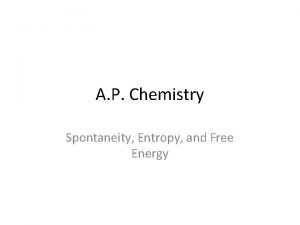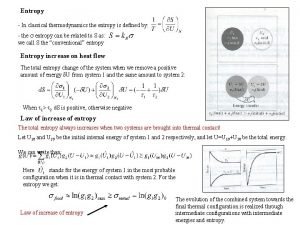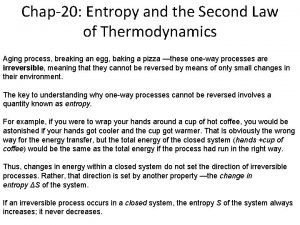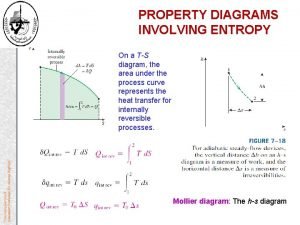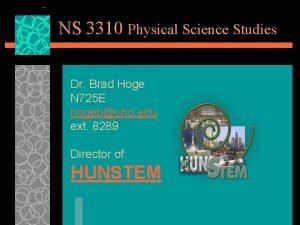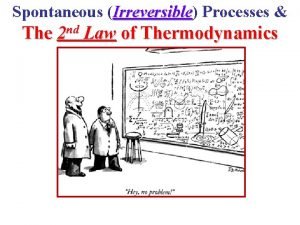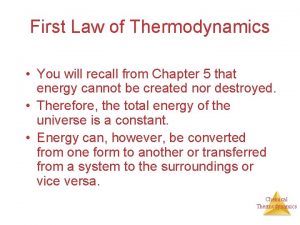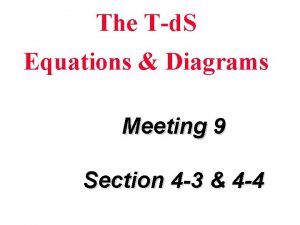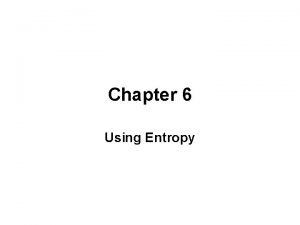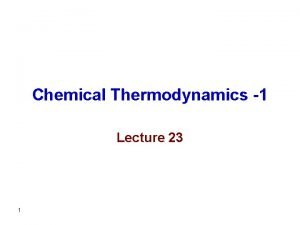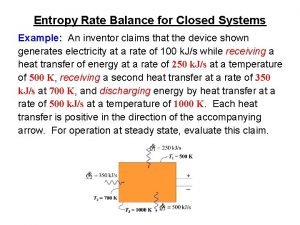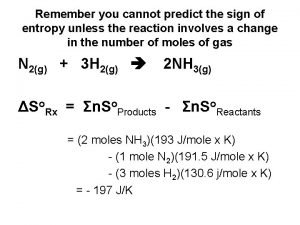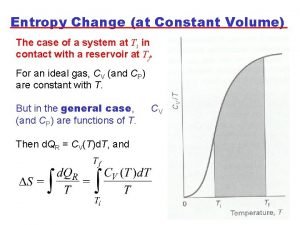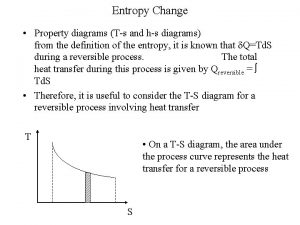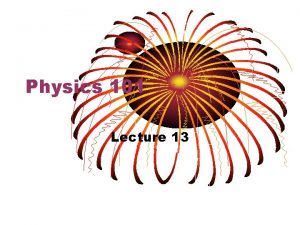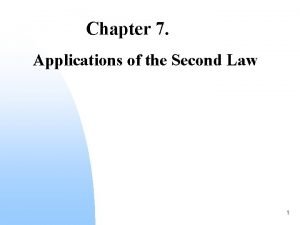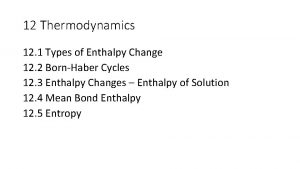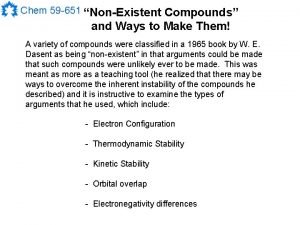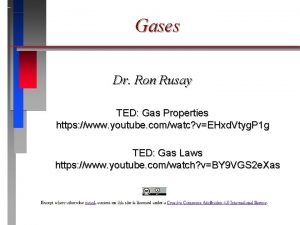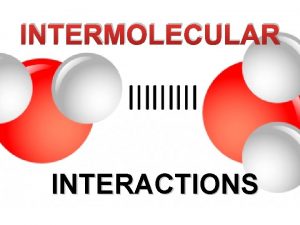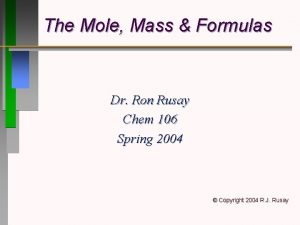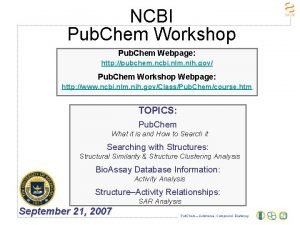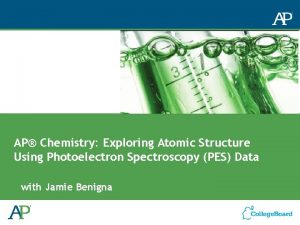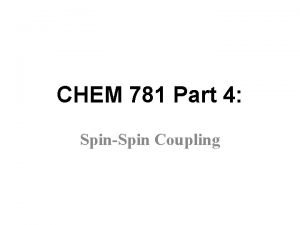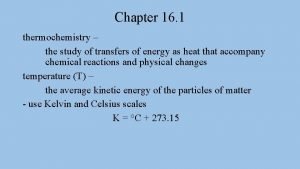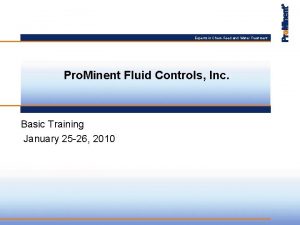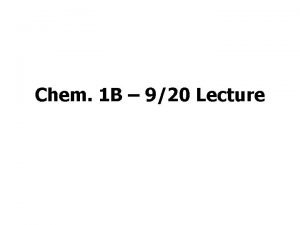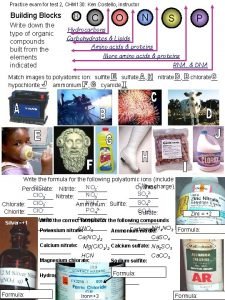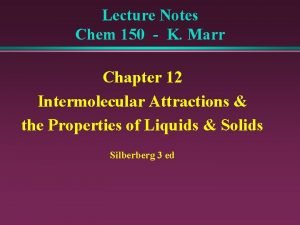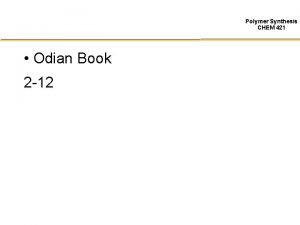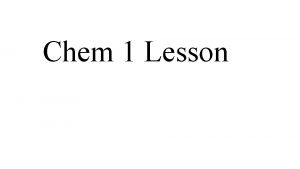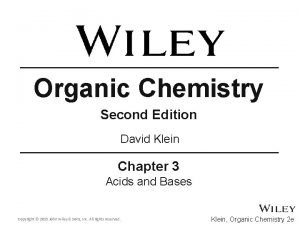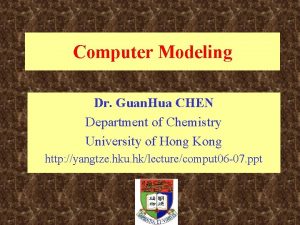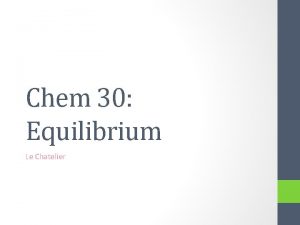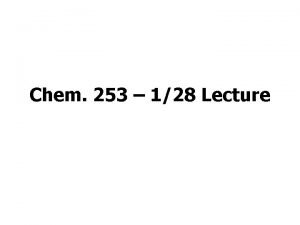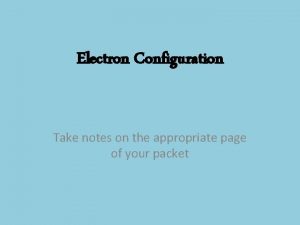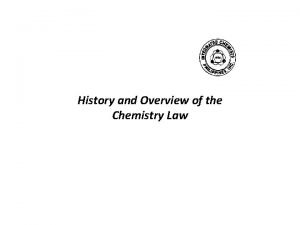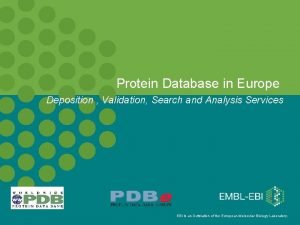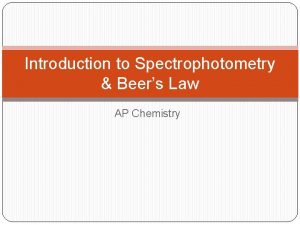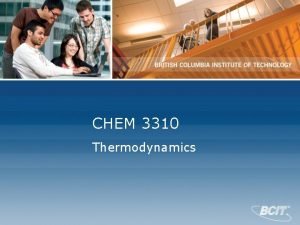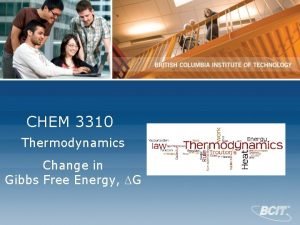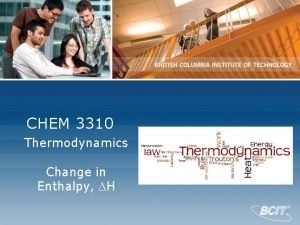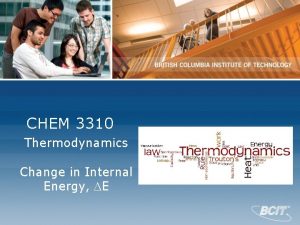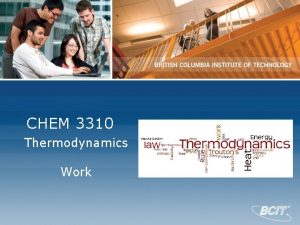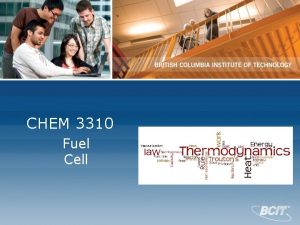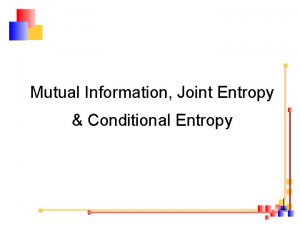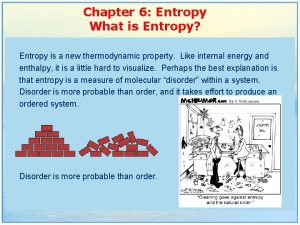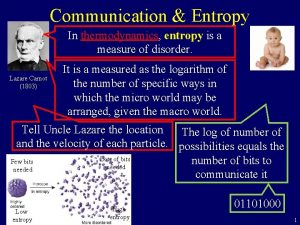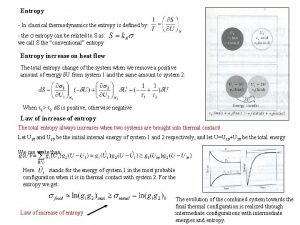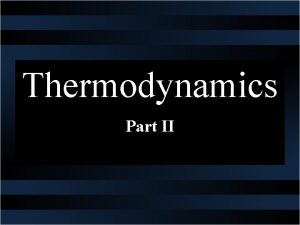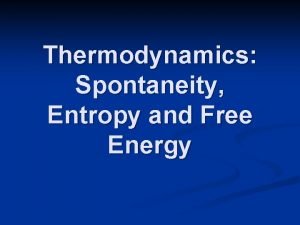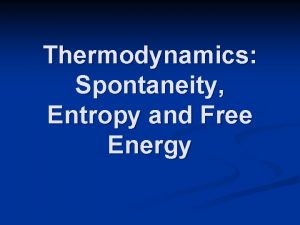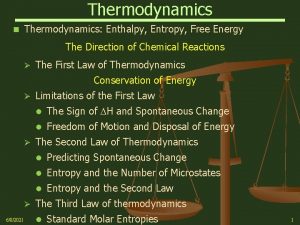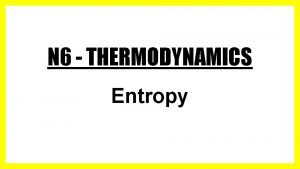CHEM 3310 Thermodynamics Change in Entropy S Entropy
























































- Slides: 56

CHEM 3310 Thermodynamics Change in Entropy, S

Entropy, S Entropy is the measure of dispersal. The natural spontaneous direction of any process is toward greater dispersal of matter and of energy. Dispersal of matter: We analyze the constraints on a system. The more the system is constrained, the less dispersed it is. Dispersal of energy: We analyze the flow of heat to measure how much energy is spread out in a particular process at a specific temperature. CHEM 3310 2

Entropy, S Entropy measures the dispersal of matter S = k ln W where W is the number of ways of describing the system, and k is the Boltzmann constant (1. 38 x 10 -23 J K-1). The more ways that the system can reside, the greater the Entropy, S. Note: If there is only one way to describe the system when W=1, the system is fully constrained. S=0 because ln (1)=0 The change in entropy is S. S = S 2 - S 1 where S 1 is the entropy of the initial state, and S 2 is the entropy of the final state. Like E and H, S is a state function. CHEM 3310 3

S = k log W Image from: http: //en. citizendium. org/wiki/Entropy_%28 thermodynamics%29

Change in Entropy, S Entropy measures the dispersal of matter Example 1: Melting of ice H 2 O (s) H 2 O (l) S = S 2 -S 1 S >0 In the ice crystal, all the molecules are constrained to fixed positions. In liquid water, molecules are free to move around. This is state 1 corresponding to an entropy state, S 1. This is state 2 corresponding to an entropy state, S 2. Image credit: http: //www. visionlearning. com/library/module_viewer. php? mid=57 CHEM 3310 5

Change in Entropy, S Entropy measures the dispersal of matter Example 2: Rusting of iron 4 Fe (s) + 3 O 2 (g) + 3 H 2 O (l) 2 Fe 2 O 3 3 H 2 O (s) S < 0 Image credit: http: //www. splung. com/content/sid/3/page/batteries CHEM 3310 6

Change in Entropy, S Entropy measures the dispersal of matter Example 3: Combustion of methane CH 4 (g) + 2 O 2 (g) CO 2 (g) + 2 H 2 O (l) S < 0 CHEM 3310 7

Change in Entropy, S Entropy measures the dispersal of matter Example 1: Melting of water S > 0 Example 2: Iron rusting S < 0 Example 3: Combustion of methane S < 0 All of the above processes are spontaneous at room temperature and atmospheric pressure. Conclusion: When a system changes spontaneously, there may be in increase of entropy ( S > 0), or a decrease in entropy ( S < 0). The above entropy changes are looking at the S of the system. But in the real world, there is always heat exchanges with the surroundings. Therefore, we must consider the entropy change of the universe. Usually when we write S, it implies S of the system ( Ssystem). CHEM 3310 8

Change in Entropy of the Universe, Suniverse The Second Law of Thermodynamics: In any spontaneous process, there is always an increase in the entropy of the universe. Suniverse = Ssystem + Ssurroundings > 0 For a spontaneous process, if there is a decrease in the Ssystem, then the heat is absorbed by the surroundings must have caused an increase in the Ssurroundings such that overall there is an increase in the Suniverse (i. e. Suniverse > 0). CHEM 3310 9

Change in Entropy, S Entropy change measures the dispersal of energy How much energy is spread out in a particular process, or how widely spread out it becomes at a specific temperature. Every process has a preferred direction – natural spontaneity. Spontaneous processes: - Contraction of a stretched elastic band - Heat flows from a warm body to a cold body These processes increases random kinetic energy of the system. As a result, an increase of energy dispersion results. CHEM 3310 10

Change in Entropy, S Entropy change measures the dispersal of energy We analyze the flow of heat to measure how much energy is spread out in a particular process at a specific temperature. Every process has a preferred direction – natural spontaneity. Let’s look at what energy dispersal means on a microscopic scale with micro-states. CHEM 3310 11

Entropy S = k ln W Entropy is a measure of the available microstates Consider a chamber with 4 particles in it. Where the particle can only have energies 2, 4, 6, 8, 10, … (i. e. the particles energy is quantized) The lowest energy state is when all 4 particles have energy = 2 or total energy is 8. There is only one way the particles can be arrange in this configuration. 4 particles with a total energy of 8

Entropy This system is now heated so that the total energy of the particles is 10. There are 4 microstates (arrangements of the particles) that satisfy Et=10. 4 particles with a total energy of 10

Entropy This system is now heated so that the total energy of the particles is 12. There are 10 microstates (arrangements of the particles) that satisfy Et=12. 4 microstates with 3 particles with E =2 and 1 particle with E = 6

Entropy This system is now heated so that the total energy of the particles is 12. There are 10 microstates (arrangements of the particles) that satisfy Et=12. 6 microstates with 2 particles with E =2 and 2 particles with E = 4 2 particles with E = 2 and 2 particles with E = 4

Entropy S = k ln This system is now heated so that the total energy of the particles is 12. There are 10 mircostates (arrangements of the particles) that satisfy Et=12. • 4 microstates with 3 particles with E =2 and 1 particles with E = 6 • 6 microstates with 2 particles with E =2 and 2 particles with E = 4 • Total of 10 microstates with total energy = 12

Entropy S = k ln This system is now heated so that the total energy of the particles is 14. There are 20 mircostates (arrangements of the particles) that satisfy Et=14. • 4 microstates with 3 particles with E =2 and 1 particle with E = 8 • 12 microstates with 2 particles with E =2 and 1 particles with E = 4 and 1 particle with E = 6 • 4 microstates with 1 particle with E =2 and 3 particles with E = 4

Entropy As the energy of the system increases the number of microstates increases. Thus the entropy of the system increases. For 4 particles with quantized energy levels of E = 2, 4, 6, … E 8 1 10 4 12 10 14 20 16 35 18 56 20 84

Entropy Consider 2 of these 4 particles system, one with E t = 8 and one with Et = 20. The systems are placed in thermal contact with each other. System 1 Eo = 8 Number of microstates 1 System 2 Eo = 20 x 84 = 84 If E = 2 units of energy are transferred from system 2 to system 1 System 1 E = 10 Number of micro states 4 System 2 E = 18 x 56 = 224

Entropy Consider 2 of these 4 particles system, one with E t = 8 and one with Et = 20. Total Energy = 28 The systems are placed in thermal contact with each other. System 1 E = E 1 System 2 E = E 2 System 2 E 1 1 E 2 2 total 8 1 20 84 84 10 4 18 56 224 12 10 16 35 350 14 20 400 16 35 12 10 350 18 56 10 4 224 20 84 8 1 84

Entropy Consider 2 of these 4 particles system, one with E t = 8 and one with Et = 20. Total Energy = 28 The probability of a finding a given amount of energy in system 1 is show in the graph Notice that the most likely outcome is when systems 1 and 2 have equal energy

Change in Entropy, S On a molecular scale The number of microstates and, therefore, the entropy tends to increase with increases in: • Temperature • Volume (gases) • The number of independently moving molecules CHEM 3310 22

Entropy, S Entropy is related to the various modes of motion in molecules. Translational: Movement of the entire molecule from one place to another. Vibrational: Periodic motion of atoms within a molecule. Rotational: Rotation of the molecule on about an axis or rotation about bonds. Image credit: Chemistry, The Central Science, 10 th edition Theodore L. Brown, H. Eugene Le. May, Jr. , and Bruce E. Bursten CHEM 3310 23

Entropy, S • More particles lead to more energy states, and therefore, more entropy • Higher temperature lead to more energy states, and therefore, more entropy • Less structure (gas is less structured than liquid, which is less structured than solid) lead to more states, and therefore, more entropy Entropy increases with the freedom of motion of molecules. Therefore, S(g) > S(l) > S(s) CHEM 3310 24

Change in Entropy, S More spontaneous processes: - Free expansion of a gas S > 0 This process neither absorbs nor emits heat. - Combustion of methane S < 0 CH 4 (g) + 2 O 2 (g) CO 2 (g) + 2 H 2 O (l) The process produces heat (exothermic). - Melting of ice cubes at room temperature S > 0 H 2 O (s) H 2 O (l) This process requires heat (endothermic). Conclusion: Naturally spontaneous processes could be exothermic, endothermic, or not involving heat. CHEM 3310 25

Change in Entropy, S More spontaneous processes: Photosynthesis Complex and highly-energetic compounds (compared to the starting materials, CO 2 and H 2 O) are formed, it appears that there a decrease in entropy in the process. CHEM 3310 26

Change in Entropy, S S<0; It appears that there a decrease in entropy in this natural process. A good example is photosynthesis. Photosynthesis in a plant does not consist of a isolated system of the plant alone. Experiments and calculations indicate that the maximum efficiency of photosynthesis in most plants is in the 30% range. This means: • 30% of the sunlight that strikes the plant is absorbed by the plant in the photosynthesis of substances that decreases entropy in the plant. Image credit: http: //www. eoearth. org/article/Photosynthesis • 70% of the sunlight that strikes the plant is dispersed to the environment (an entropy increase in slightly heating the leaf and the atmosphere. When the system and surroundings are considered, there is a net increase in entropy as a result of photosynthesis! CHEM 3310 27

Change in Entropy, S For any spontaneous process, Suniverse = Ssystem + Ssurroundings > 0 Spontaneous process, • favoured by a decrease in H (exothermic) • favoured by an increase in S Nonspontaneous process, • favoured by an increase in H (endothermic) • favoured by an decrease in S CHEM 3310 28

Change in Entropy, S Entropy measures the dispersal of energy At a specific temperature, the change in entropy, S, is where qrev is the heat transferred at a constant temperature T in Kelvin. What is qrev? CHEM 3310 29

Change in Entropy, S What is qrev? Consider a gas in a piston and cylinder configuration. The gas is held in place by a pile of sand. The gas undergoes isothermal expansion. Recall E = q+w Since E = 0 for an isothermal process, q is the same magnitude of w but opposite in sign. Let’s take the PV curve of five different paths to take the gas from State I to State F. Work done by the gas (w<0) is the area under the PV curve. wrev wirrev This is the reversible path. The area under the PV curve is the greatest. This path yields the smallest w (most negative), and the largest q. We refer to the heat transfer of a reversible path reversible q, q rev. Of all the different possible paths to take the gas from State I to F, q rev is the limit of the observed heat transferred. CHEM 3310 30

Entropy, S What is qrev? Likewise, consider a gas in a piston and cylinder configuration. The gas is held in place by a pile of sand. The gas undergoes isothermal compression. Since E = 0 for an isothermal process, q is the same magnitude of w but opposite in sign. Let’s take the PV curve of five different paths to take the gas from State I to State F. Work done on the gas (w>0) is the area under the PV curve. wrev wirrev This is the reversible path. The area under the PV curve is the smallest. This path yields the smallest w, and the largest q (least negative). We refer to the heat transfer of a reversible path reversible q, q rev. Of all the different possible paths to take the gas from State I to F, q rev is the limit of observed heat transferred. CHEM 3310 31

Change in Entropy, S What is qrev? A reversible change is one that is carried out in such a way, such that, when the change is “undone”, both the system and the surroundings remain unchanged. This is achieved when the process proceeds in infinitesimal steps that would take infinitely long to occur. Reversibility is an idealization that is unachievable in real process, except when the system is in equilibrium. A process that is carried out reversibly has the smallest wrev, and the largest qrev. CHEM 3310 32

Change in Entropy, S Entropy measures the dispersal of energy To express entropy is to describe the number of arrangements for positions and/or energy levels available to a system — a measurement of dispersion. At a specific temperature, the change in entropy, S, is where qrev is the heat transferred at a constant temperature T in Kelvin. • Although most real processes are irreversible, there are real reversible processes. • Consider ice melting at 0 o. C, where Hfusion = 79. 71 cal/g = 6. 003 k. J/mole This is a reversible process. If the heat is absorbed in small enough increments such that it does not disturb the equilibrium, this is a reversible process. There is an increase in the entropy of water when ice melts to form liquid water. CHEM 3310 33

Change in Entropy, S • Similarly, consider water vapourizing at 100 o. C, where Hvapourization = 40. 7 k. J/mole This is a reversible process. If the heat is absorbed in small enough increments such that it does not disturb the equilibrium, this is a reversible process. There is an increase in the entropy of water when water is converted to steam. Note: S for the vapourization of water is much higher than that of fusion. CHEM 3310 34

Change in Entropy, S Expansion of an Ideal Gas Recall how we define a reversible process. For the expansion of a gas in a piston and cylinder configuration under constant temperature condition. Since E = 0 for an isothermal process, q is the same magnitude of w but opposite in sign. Work done by the gas (w<0) is the area under the PV curve. It follows that wrev or Entropy increases with an increase in volume or a decrease in pressure. CHEM 3310 35

Change in Entropy in the surroundings, Ssurroundings Entropy Changes in Surroundings • Heat that flows into or out of the system also changes the entropy of the surroundings. • For an isothermal process: • At constant pressure, qsys is H for the system. CHEM 3310 36

Change in Entropy in the surroundings, Ssurroundings A phase change is isothermal (no change in T). For H 2 O: Hfusion = 6. 003 k. J/mole Hvapourization = 40. 7 k. J/mole If this is done reversibly: Ssurr = – Ssys CHEM 3310 37

Example: 1. 00 mole of a monatomic ideal gas at 273 K is expanded via two paths: (a) isothermally and reversibly from 22. 4 L to 44. 8 L. Find w, q, E, H, Ssystem, Ssurroundings, and Suniverse. Under isothermal condition, T=0, therefore E = H = 0 External pressure, Pext (w < 0) Since E depends only on temperature, E = 0 and H = E + (PV) = E + (n. RT) = 0 This is because work of expansion done by the gas equals to the heat flow into the system. q Net overall change in internal energy and enthalpy is zero. (q > 0) This is Ssystem. What is Ssurroundings? What is Suniverse? Since qsurr = -qsys, qsurr = -1. 574 k. J CHEM 3310 qrev = S T = 5. 764 273 = 1. 574 k. J Since E = 0, w = -q = -1. 574 k. J This is true for a reversible process. The system is at equilibrium. 38

Example: 1. 00 mole of a monatomic ideal gas at 273 K is expanded via two paths: (b) via free expansion from 22. 4 L to 44. 8 L. Find w, q, E, H, and Ssystem, Ssurroundings, and Suniverse. This is an irreversible process with no change in temperature, T=0. As a result, E = H = 0 w = 0 because Pext = 0 w = -q, q =0 Since E depends only on temperature, E = 0 and H = E + (PV) = E + (n. RT) = 0 To calculate S, we need to find a reversible path that will take the gas from the same initial state to the same final state. Part (a) is such a path. This is Ssystem. It has the same disorder as calculated in Part (a). What is Ssurroundings? What is Suniverse? This is a spontaneous process. Suniverse > 0 Since the no heat flowed into the surroundings, qsurr = 0, CHEM 3310 39

Change in Entropy, S Entropy associated with temperature change Recall, q = n C T At a specific temperature T where n = number of moles C = molar heat capacity T = temperature difference For a change in temperature of n moles of substance from T 1 to T 2 where the heat capacity is constant over the temperature range. Under constant volume condition CHEM 3310 Under constant pressure condition 40

Change in Entropy, S Entropy associated with temperature change At a specific temperature T For a change in temperature of n moles of substance from T 1 to T 2 and the heat capacity is expressed as a power series, a + b. T + c. T 2 + … T in Kelvin S H Compare CHEM 3310 41

Change in Entropy, S Calculate S for the change in state S Increase the volume of the container. The amount of gaseous H 2 O present is governed by the vapour pressure of water at 25 o. C. Given Cp (H 2 O, liq) = 18 cal mole-1 K-1 Cp (H 2 O, g) = 9. 0 cal mole-1 K-1 Hvap = 9713 cal/mole (at 373 K) Let’s devise a reversible process to calculate S. S Warming liquid water, S 1 Cooling gaseous water, S 3 S 2 CHEM 3310 S = S 1 + S 2 + S 3 42

Change in Entropy, S Calculate S for the change in state S Given Cp (H 2 O, liq) = 18 cal mole-1 K-1 Cp (H 2 O, g) = 9. 0 cal mole-1 K-1 Hvap = 9713 cal/mole (at 373 K) S > 0 S < 0 S Warming liquid water, S 1 Cooling gaseous water, S 3 S 2 S > 0 S = S 1 + S 2 + S 3 = 4. 04 + 26. 04 - 2. 02 = 28. 1 cal K-1 CHEM 3310 43

Change in Entropy, S Trouton’s Rule A useful generalization that works for many liquids at their normal boiling point (i. e. boiling point at 1 atm) is that, the standard molar entropy of vapourization has a value of about 22 cal mole-1 K-1 or 88 J mole-1 K-1 Since The idea is, if the degree of disorder associated in the phase transformation of 1 mole of liquid to 1 mole of vapour at 1 atm is the same, then the Sovapourization of different liquids should be similar. Sovapourization = 22 cal mole-1 K-1 or 88 J mole-1 K-1 Trouton’s rule is useful method for estimating the enthalpy of vapourization of a liquid if its normal boiling point is known. Example: We can estimate the enthalpy of vapourization of Hg using Trouton’s rule from the normal boiling point of Hg. The normal boiling point of Hg is 357 o. C. Compare: Hvapourization = 630 K 88 J mole-1 K-1 = 55 k. J mole-1 CHEM 3310 Heat of vaporization of mercury: 59. 11 k. J mol -1 Cited value: Wikipedia http: //en. wikipedia. org/wiki/Mercury_%28 element%29 44

Change in Entropy, S Trouton’s Rule Sovapourization = 22 cal mole-1 K-1 or 88 J mole-1 K-1 Substance Hvap (kcal mole-1) Tb o ( C) Svap (cal mole-1 K-1) O 2 1. 630 -182. 97 18. 07 CH 4 1. 955 -161. 49 17. 51 H 2 O 9. 717 100. 0 26. 04 NH 3 5. 581 -33. 43 23. 28 C 2 H 5 OH 9. 23 78. 3 26. 27 CHCl 3 7. 02 61. 2 20. 8 C 6 H 6 7. 36 80. 1 20. 83 (C 2 H 5)2 O ether 6. 21 34. 5 20. 18 (CH 3)2 CO acetone 7. 22 56. 2 21. 90 In liquid state, hydrogen bonding between molecules produces a greater degree of order than expected. As a result, the degree of disorder produced in the vapourization process is generally greater than the nominal 22 cal mole-1. CHEM 3310 45

Entropy, S The Third Law of Thermodynamics: The entropy of a pure perfect crystal is zero when the crystal is at zero Kelvin (0 K) A pure perfect crystal is one in which every molecule is identical, and the molecular alignment is perfectly even throughout the substance. For non-pure crystals, or those with less-than perfect alignment, there will be some dispersal of the imperfection, so the entropy cannot be zero. Image credit: Chemistry, The Central Science, 10 th edition Theodore L. Brown, H. Eugene Le. May, Jr. , and Bruce E. Bursten 46

Entropy, S The entropy of the crystal gradually increases with temperature as the average kinetic energy of the particles increases. As the crystal warms to temperatures above 0 K, the particles in the crystal start to move, generating some disorder. The entropy of the liquid gradually increases as the liquid becomes warmer because of the increase in the vibrational, rotational, and translational motion of the particles. At the melting point, Tm, the entropy of the system increases in entropy without a temperature change as the compound is transformed into a liquid, which is not as well ordered as the solid. CHEM 3310 At the boiling point, there is another increase in the entropy of the substance without a temperature change as the compound is transformed into a gas. 47

Standard Molar Entropy, So Standard entropies (measured at 298 K) have been carefully measured for many substances. For example, the standard molar entropy of some solids: CHEM 3310 So J K-1 mole-1 C(diamond) 2. 38 C (graphite) 5. 74 Sodium 51. 3 Phosphorus (white) 41. 1 Sulfur (rhombic) 31. 8 Silver 42. 6 48

Standard Molar Entropy, So Standard entropies (measured at 298 K) have been carefully measured for many substances. For example, the standard molar entropies (standard entropy per mole) for gases are usually higher because heat of melting and heat of vapourization must be included. The standard molar entropies for noble gases are: CHEM 3310 So J K-1 mole-1 He 126. 0 Ne 146. 2 Ar 154. 7 Kr 164. 0 Xe 169. 6 For liquids and gases So are usually higher because heat of melting and heat of vaporization must be included. 49

Standard Molar Entropy, So Standard entropies (measured at 298 K) have been carefully measured for many substances. For example, the standard molar entropies (standard entropy per mole) for diatomic gases. So J K-1 mole-1 H 2 130. 6 N 2 191. 5 O 2 205. 1 For diatomic gases, they are usually higher than those of monatomic noble gases as there are more degrees of freedom of motion. Halogens: F 2 203. 7 Cl 2 222. 9 Br 2 245. 4 I 2 260. 6 CHEM 3310 50

Standard Molar Entropy, So Standard entropies (measured at 298 K) have been carefully measured for many substances. For example, the standard molar entropies (standard entropy per mole) for more gases. So J K-1 mole-1 CH 4 (g) 186. 3 C 2 H 2 (g) 200. 8 C 2 H 4 (g) 219. 5 C 2 H 6 (g) 229. 6 C 3 H 8 (g) 270. 3 In general, the more complicate the molecule and the heavier the molar mass, the higher the standard entropy. Image credit: Chemistry, The Central Science, 10 th edition Theodore L. Brown, H. Eugene Le. May, Jr. , and Bruce E. Bursten CHEM 3310 51

Standard Molar Entropy, So For example, the standard molar entropies (standard entropy per mole) for compounds. So J K-1 mole-1 H 2 O (l) 69. 9 H 2 O (g) 188. 7 H 2 O 2 (l) 110. 0 CO (g) 197. 8 CH 3 OH(l) 126. 9 CO 2 (g) 213. 6 CH 3 Cl(l) 145. 3 NO (g) 210. 6 CHCl 3(l) 202. 9 NO 2 (g) 240. 4 N 2 O 4 (g) 304. 3 SO 2 (g) 248. 4 A NO molecule has only one type of vibrational molecule A NO 2 molecule has three types of vibration. 52

Standard Entropy for Aqueous Ions • These are not ‘third law’ entropies, presumably because the task of working up from absolute zero is too complex a task for aqueous ions. • The hydrogen ion, is arbitrarily chosen to have an entropy of zero and all other ions are compared with it. • Some of these other ions have greater entropy than the hydrogen ions, some lower, hence the negative values. So (J K-1 mole-1) H+ (aq) OH- (aq) H 2 O (l) 0 -10. 7 70. 0 H+(aq) + OH-(aq) H 2 O(l) So = So(H 2 O (l)) – (So(H+(aq)) - So(OH-(aq)) So = 70. 0 – (0 -10. 7) So = 80. 7 J K-1 CHEM 3310 53

Sreactiono Calculate the change in Entropy of a reaction from Standard Molar Entropy. CHEM 3310 54

Sreactiono Calculate the standard entropy change accompanying the burning of ethane, C 2 H 6 (g) + 7/2 O 2 (g) 2 CO 2 (g) + 3 H 2 O (g) So J K-1 mole-1 C 2 H 6 (g) 229. 5 O 2 (g) 205. 1 CO 2 (g) 213. 6 H 2 O (g) 188. 7 S = ? In general, the more complicate the molecule and the heavier the molar mass, the higher the standard entropy. So = 2 So(CO 2 (g)) + 3 So(H 2 O (g)) – (So(C 2 H 6 (g)) + 7/2 So(O 2 (g))) So = 2(213. 6) + 3 (188. 7) – (229. 5 + 7/2 (205. 1)) So = 46. 3 J K-1 CHEM 3310 55

Summary: • The Second Law of Thermodynamics: In any spontaneous process, there is always an increase in the entropy of the universe. Suniverse = Ssystem + Ssurroundings > 0 • Change in entropy, S, at a specific temperature, T. • Change in entropy, S, measured over a temperature range from T 1 to T 2. • Assuming that Cv and Cp are constant from T 1 to T 2. • For an isothermal process expansion or compression of a gas. • The Third Law says the entropy of a pure perfect crystal is zero when the crystal is at zero Kelvin (0 K). For a chemical reaction, So can be calculated from the reactants’ and products’ standard molar entropies. CHEM 3310 56
 Ap chemistry entropy and free energy
Ap chemistry entropy and free energy What is entropy in thermodynamics
What is entropy in thermodynamics Entropy in thermodynamics
Entropy in thermodynamics Entropy thermodynamics
Entropy thermodynamics District 3310
District 3310 Ns 3310
Ns 3310 Rfc3310
Rfc3310 Fin 3310
Fin 3310 3310
3310 What is the change of entropy in an irreversible process
What is the change of entropy in an irreversible process Entropy change formula
Entropy change formula Mathematical statement
Mathematical statement Isentropic compressor
Isentropic compressor Constant entropy
Constant entropy Standard entropy change formula
Standard entropy change formula Entropy formula
Entropy formula δhsys
δhsys Constant entropy
Constant entropy Hs diagram
Hs diagram Change in entropy formula
Change in entropy formula Adiabatic irreversible
Adiabatic irreversible Enthalpy of atomisation
Enthalpy of atomisation Chem
Chem Chem pro 100
Chem pro 100 Chem data extractor
Chem data extractor Chem 301 gas law simulator
Chem 301 gas law simulator Dipole induced dipole
Dipole induced dipole Chem moles
Chem moles January 2018 chemistry regents
January 2018 chemistry regents Ap chem equilibrium
Ap chem equilibrium Dyno chem
Dyno chem Chem pub
Chem pub Www.chem.purdue/gchelp/atoms/elements.html
Www.chem.purdue/gchelp/atoms/elements.html Amorphous vs crystalline
Amorphous vs crystalline Photoelectron spectroscopy ap chemistry
Photoelectron spectroscopy ap chemistry Geminal coupling
Geminal coupling Specific heat chem worksheet 16-1
Specific heat chem worksheet 16-1 Nss chemistry
Nss chemistry Chem
Chem Gen chem cheat sheet
Gen chem cheat sheet Chem feed
Chem feed Chem
Chem Chem
Chem Chem 130 final exam
Chem 130 final exam Chem 150
Chem 150 Chem
Chem Chem connections india
Chem connections india Chem
Chem Molecular geometry
Molecular geometry Ario organic chem
Ario organic chem Guan chem chen
Guan chem chen Chem 30 equilibrium
Chem 30 equilibrium Chem 253
Chem 253 Chem.fsu.edu
Chem.fsu.edu Chemistry law hazard pay
Chemistry law hazard pay Pdbe pisa
Pdbe pisa Ap chemistry beer's law frq
Ap chemistry beer's law frq
